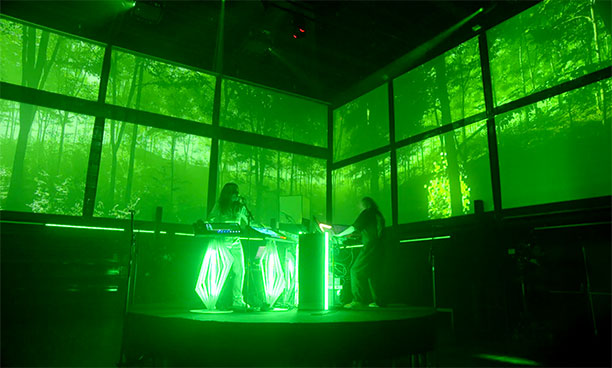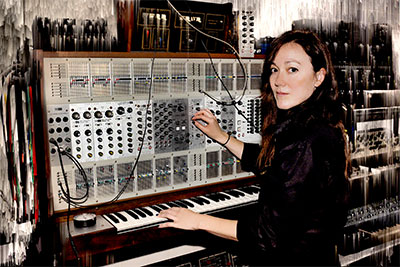
Taking its title from a 1930s French artistic movement in which painters translated sounds into visual art to evoke specific emotional responses, French electronic artist DeLaurentis’ latest work resonates with her own synesthetic experiences.
DeLaurentis invited Hervé Déjardin to her recording studio in the south of France, where they recorded the sonic universe of a painter’s studio for use on the full-length album, Musicalism.
To bring the concept to life, she began creating an extensive library of sounds associated with visual art in association with Hervé Déjardin from Radio France. ‘We wanted to capture the sonic essence of the creative process itself.’ she says.
The material was then edited, mixed, and shaped into a library of artistic sounds that DeLaurentis was able to use throughout the album’s production. The project was mixed by Hervé Déjardin, who is Head of Audio Innovation at Radio France, using L-ISA Studio spatial audio mixing tools from L-Acoustics. Déjardin also co-composed ‘White Opening’ the album’s opening track, and the pair have launched a live immersive audio-visual show scheduled to tour France and Great Britain throughout 2025.
 The collaboration began when Déjardin and DeLaurentis met at Radio France’s Le Cube experimental audio lab at the broadcaster’s Paris HQ. Discovering shared inspirations including Bach, Ryuichi Sakamoto, Jay-Jay Johanson, with whom DeLaurentis has collaborated many times and Jean-Michel Jarre, with whom Déjardin has worked.
The collaboration began when Déjardin and DeLaurentis met at Radio France’s Le Cube experimental audio lab at the broadcaster’s Paris HQ. Discovering shared inspirations including Bach, Ryuichi Sakamoto, Jay-Jay Johanson, with whom DeLaurentis has collaborated many times and Jean-Michel Jarre, with whom Déjardin has worked.
‘DeLaurentis knew my work with Jean-Michel Jarre and wanted me to create the immersive mixes,’ Déjardin explains. ‘But she was equally drawn to my sound design capabilities, which became essential to realising her vision.’
‘For me, music and innovation are intrinsically linked,’ says DeLaurentis. ‘I’ve had the opportunity to work with IRCAM and Sony CSL on AI-based tools, and I had always dreamed of collaborating with Radio France, especially on electroacoustic music. That’s why meeting Hervé was the starting point of the album.’
Their collaboration deepened when DeLaurentis suggested they co-compose ‘White Opening’. Conceived as an electroacoustic piece that gradually evolves into electronic music, the track represents an entry into the painter’s sonic universe. ‘We tried to capture that sensation of beginning a new work – facing a blank canvas full of possibilities,’ explains Déjardin. Through this track, they also discovered how spatial composition was particularly enhanced by the presence of electroacoustic sounds, which added depth and texture to the immersive experience.
DeLaurentis conceived Musicalism as a ‘spatialised auditory experience’ from its inception, producing it in Dolby Atmos while simultaneously developing a 360° live experience in partnership with Radio France, La Générale de Production and France Télévisions. Working in Le Cube’s 12.0.6 loudspeaker configuration, Déjardin used L-ISA Studio to manage up to 96 audio objects before rendering the spatial mix into Nuendo with the Atmos monitoring plug-in. This workflow allows him to maintain both L-ISA object mode and Atmos object mode within the same project, enabling seamless reference between 7.1.4, 5.1.4, and binaural formats. ‘I constantly monitor through the Atmos renderer because it simulates the audience experience,’ Déjardin notes. ‘If the mix works in 5.1, I know the 12.0.4 version will translate beautifully.’
Déjardin’s relationship with L-Acoustics extends beyond using their tools as he actively contributes to product development through ongoing dialogue with the company. ‘As a composer and engineer, I can communicate specific needs for functionality – and they listen. That collaborative approach is invaluable.’
He particularly values L-ISA’s stability during extended studio sessions and its translation from studio to live performance. ‘I can design an album mix and translate it directly to live performance using the same toolset,’ he says. ‘That continuity is crucial for maintaining artistic vision across formats.’
With nearly two decades’ experience working in immersive audio, Déjardin views spatial sound as more than a technical advance. ‘It’s truly a new art form,’ he asserts. ‘The creative universe available in immersive formats offers possibilities that continue to inspire me after 20 years. Each project reveals new potential.’
For her part, DeLaurentis discovered spatial audio mixing with L-ISA, and it brought about a revolution in her work: ‘I tend to orchestrate my musical productions extensively, and for years I was frustrated by having to make compromises in my stereo mixes,’ she explains. ‘With spatial sound, there is no longer a hierarchy of sounds, ornamentations and appoggiaturas are just as important as the main melodies. All elements of the score coexist harmoniously.’
As Musicalism tours throughout 2025, it demonstrates how innovative technology can serve artistic vision, creating experiences where audiences don’t simply hear music but step inside DeLaurentis’ synesthetic world where sound and colour converge.
More: www.l-acoustics.com

